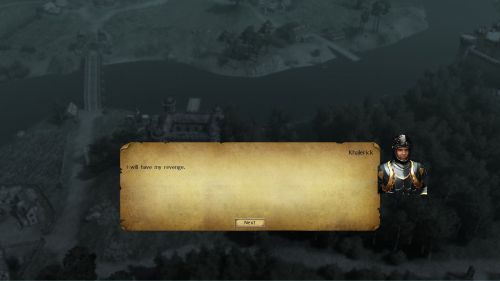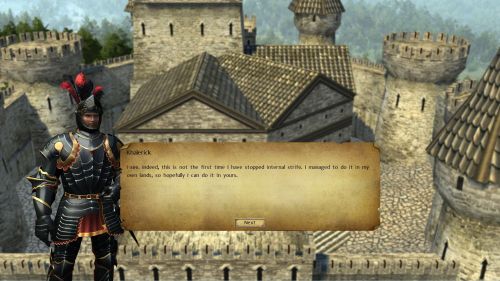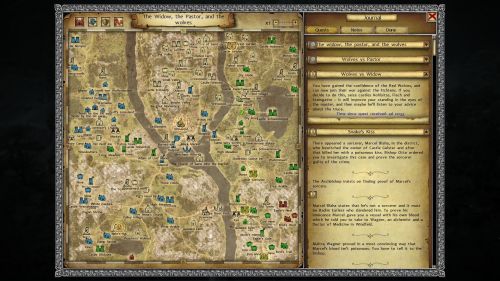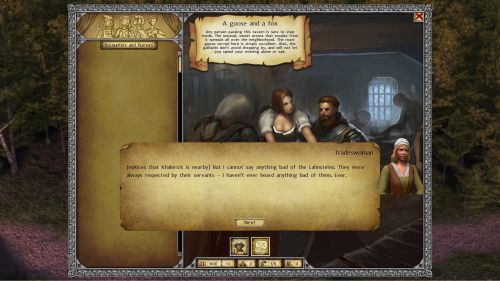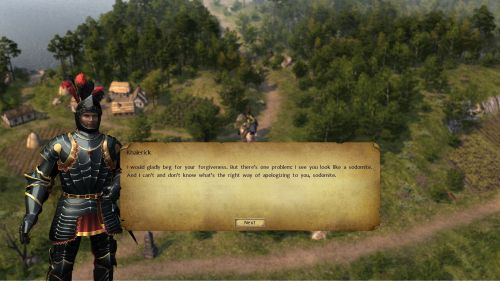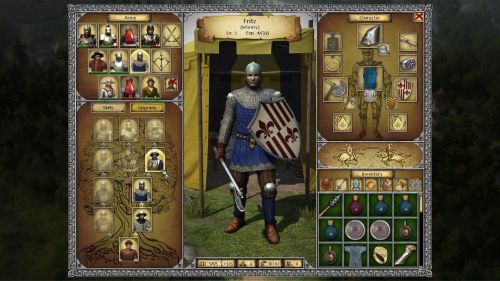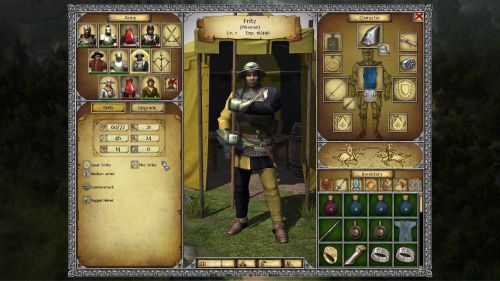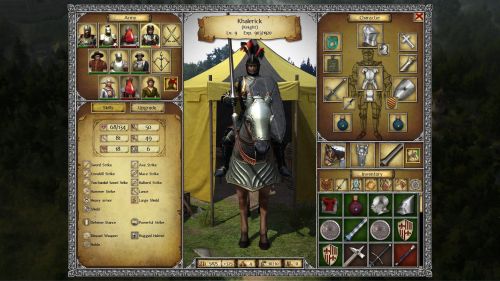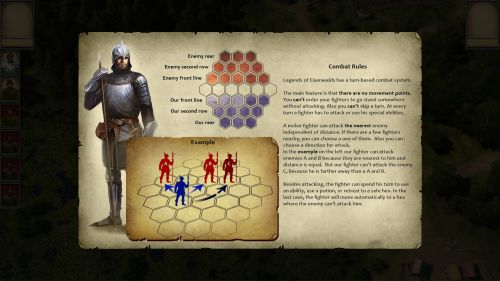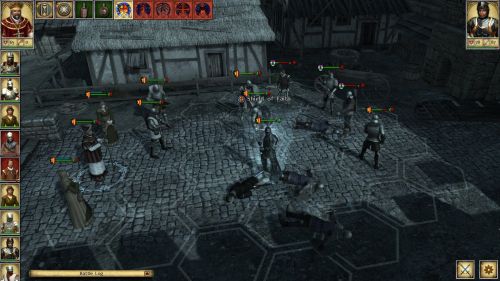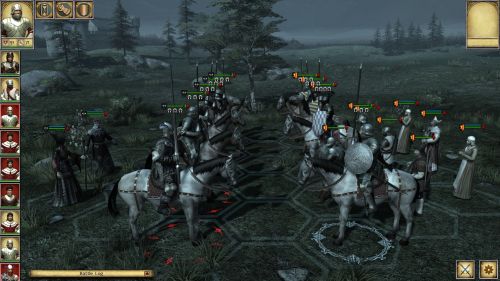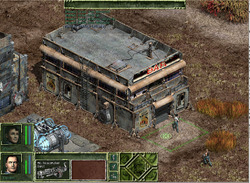RPG Codex Review: Legends of Eisenwald
RPG Codex Review: Legends of Eisenwald
Review - posted by Crooked Bee on Wed 8 July 2015, 15:39:49
Tags: Aterdux Entertainment; Legends of EisenwaldSomewhere in Eastern Europe, there is a country called Belarus that is totally not a part of Russia. There, a studio called Aterdux Entertainment has been working on a medieval Strategy RPG Legends of Eisenwald, now out of Early Access and available on Steam. It took them more than three years to release the game after the Kickstarter they did in early 2012 (promising the late 2012 release date), so is it any good?
Esteemed community member sser is here to answer that question and generally tell you all you need to know about the game.
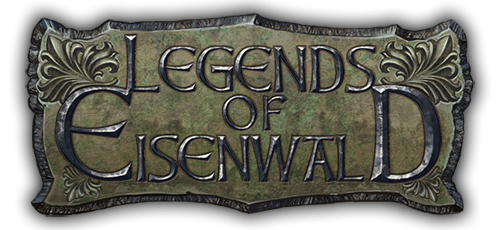
The full review can be found here, but first, have a snippet:
There, now go ahead and read the full thing instead of just basing your judgment on a random snippet. In contrast to my ramblings here, it's really well-written, to the point, and deserves to be read in its entirety.
Read the full article: RPG Codex Review: Legends of Eisenwald
Esteemed community member sser is here to answer that question and generally tell you all you need to know about the game.

The full review can be found here, but first, have a snippet:
Legends of Eisenwald is a solid game.
There, now go ahead and read the full thing instead of just basing your judgment on a random snippet. In contrast to my ramblings here, it's really well-written, to the point, and deserves to be read in its entirety.
Read the full article: RPG Codex Review: Legends of Eisenwald
[Review by sser]
Legends of Eisenwald is – per its own marketing – a RPG/tactics/strategy game set in medieval Germany. While it tries to distance itself from being a fantasy game, it definitely has its fair share of fantastical elements though it tries very hard to take itself more seriously. I’m not sure why devs these days try to shoehorn in how ‘real’ their games are. To quote the game (Steam) box: “it’s a land where the superstitions of the time have come to life. This isn’t a fantasy game.” Dammit devs, you can’t bring superstitions to life and then turn right around and say it isn’t a fantasy game. If ya got spells and wizards and necromancers, it’s got some fantasy! Maybe it’s the fear of getting washed out by the sea of fantasy games in this same genre, but I say don’t be afraid to own it.
That poor opening aside, let’s just get right down to it: Legends of Eisenwald is a solid game.
Picking up a well-worn calling card, the protagonist of the story is on a vengeful warpath as he or she looks for those responsible in bringing down their dynasty. You can pick from three characters – a Knight (melee), Baroness (ranged), and Mystic (magic). Because your characters physically take part in the battles, who you choose can greatly shape how you end up playing the game. That is, after all, one of the subtler differences amongst these genre games: whether or not you, the play-character, physically take part in the battles. Unlike King’s Bounty, without actual spellcasters in your party, you will not be casting very many spells if you are not a spellcaster (read: very many is actually very none). Most of these characters have various ‘leveling paths’ that usually fall along the lines of empire management, army management, and character power-growth. For me, I chose the Knight as it was suggested to be the easiest and I’m a simpleton that likes to bash. Not only that, I also leveled him to be extra-bashy in the early game where he promptly served as a valuable extra-soldier instead of an anchor of ‘potential’ that the Mystic certainly is. With the character choice out of the way, you pretty much jump into the story which is structured by a series of scenarios.
Most scenarios play out almost necessarily obstructive and centripetal: you come into some new tract of territory upon which scurry a handful of lords and barons that dislike one another. The first man you meet says he can do X for you, all you need to is round up the rascals and spalpeens – usually by means of killing one half for the beneficial alliance of the other – and once all that is said and done you’re on to the next scenario wherein the process repeats itself. I have to admit by the later chapters I would be doing a bit of a sideways glance as I read another lord go on about how I needed to unite this particular tract of territory. After a few scenarios I kinda started to wonder, if in every map I leave I’m controlling the majority of the castles and land, why don’t I just… snowball that into an actual army? Uniting lands for some other dick? How about the fact I’m actually just conquering them myself? Amusingly, while worrying word of your nemesis’s army roaming unseen lands meets your ears on every map, nobody seems to notice the last member of a dying dynasty reaping a whirlwind of destruction himself.
In between the here of this scenario and the there of that one, you run across various characters of ill-repute. Taking a page out of Game of Thrones, LoE’s sense of fantasy is a dark one. Most people are intolerable assholes asking you to do dreadful things to which you doth protest not at all. ‘Good actions’ typically require some amount of investment while ‘evil actions’ often expedite the completion of an objective. Would you rather run back and forth across the world in search of something, or just unsheathe your sword and be done with it? Nevermind that most good actions are duplicitous in nature – what you think is a ‘good’ action is, in fact, a naïve and ignorant one that ends rather horribly. Like Game of Thrones, the subversion becomes a trope in and of itself and characters are a little bit too obviously evil.
Of course, the biggest jerk in the game is you, the player character. Peasants look at your lord side-eyed and if you ever get a word with them they respond with the lit-up, faux grin of a noticed Best Buy worker trying to hide behind the DVDs. LoE really plays upon how you are a member of nobility, and how the laymen are way, way beneath your stature. The fantasy trope of the kindhearted liege is very quickly done away with. After the third scenario there should be little doubt that you are, in fact, just another asshole. I quite liked it, though, and there’s a great deal of humor to be found in how narrow-minded your character is in their pursuit of vengeance. I was often reminded of the Russian nobility’s stupidly naïve diaries in its final days. What’s wrong with throwing a few peasants to their deaths? I don’t understand what there is to be upset about.
Legends of Eisenwald is a pretty game in the sense that it is the cutest German girl in a small village. She would become just another face in the engulfing nature of a city, but here in the tiny hamlet her little hair-twisting and skirt-spinning pirouettes make her stand out. I’ve clearly no idea how to talk about graphics or even appraise them, but by my estimations it’s a good looking game. Polygon-wise the characters are detailed enough, textures give them a sense of physical presence, and animations are serviceable. I think the real standout are the maps themselves. They’re intricately made and I can imagine took a great deal of time to get just right. Castles rest in the midst of lakes, murky ponds help mudify the otherwise viridscapes, lots of ruins and rubble strewn about, windmills dot hills and fortresses are oft found tucked between mountains. Oh, and forests. Lots of forests. And copses and pockets of trees where forests used to be. Most maps tend to have one big central city – or two – surrounded by temples, medieval favelas, and black markets. About all of this scurry various lords, lieges, leech-sellers, smellsmocks, witches and their corollary dick-swingin’ ne’er do wells, all manner of peasantry run amuck, bandits, brigands, and thieving graduates, some sickly and poison moistened, the cursed and rabid, the cured and vapid, sellswords and poets selling words and plenty of peddlers, tramps, shamans, pagans, pariahs, necromantic practitioners to dizzy you with lore.

Boats, bridges and lighthouses, the little flourishes man can claim to be art. Only thing missing is a train.
Sound-wise, I’m a bit mixed. The music is fantastic. It dips in and out at appropriate times and is a fair-bit catchy when you’re traipsing about the overworld. A nice little ditty plays for your battles, a little bit of pomp and flair to accompany your man-killings, and it doesn’t fall for the overly abused heavy drums or reverb or whatever the hell it is kids listen to before going into battle these days. The overly ear-friendly lute playing that kicks in when you visit noblemen helps reinforce the gulf between you and the laymen. Nothing like a little pimby-pamby music to accompany the news of how you’ve committed various atrocities in the name of your own personal ambitions. I’ve won you an ally sir, all I needed to do was slaughter every living being that stood before me and sell women into a filthy man’s harem. Doo-dee-doo.
Battle-sounds leave a lot more to be desired. There’s not enough ‘chunk’ to them. Bows go ‘pfft’ and heavy clubs go ‘bang’ and dying men go ‘augh.’ It’s a very 1950s Hollywood rendition of a fight to the death. The way men keel over you almost expect someone to yell out, “…and cut!” A man may die akin to a spirited mannequin, but you can still cover up that awkwardness with some quality sound design. Sound goes a long way in making any game that much better. Naturally, when it’s there we just go and take it for granted, but when it’s missing it’s hard to not notice its absence. What we come to have are what I would call ‘noises.’
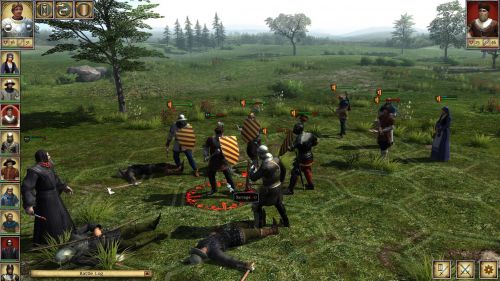
Imagine going to Medieval Times, but there are no other spectators or loudspeakers.
Gameplay, or kite-watching in slow motion
Recap for fluff skippers: Legends of Eisenwald is played over a number of scenarios. So what is it you do in those scenarios?
Fight, mostly.
Legends of Eisenwald’s battle system, however, is particularly unique and no doubt the fulcrum upon which will totter both positive and negative opinions about the game. But there are a few steps to be taken before you lay low your enemies.
Firstly, hiring, leveling, and equipping your followers. You don’t recruit armies in LoE, but instead individuals which round out a small band of killers. Followers range from melee brutes, ranged shooters, and spell-casters, not unlike what you had to choose from for your player-character. However, there are some differences amongst these units. They all follow ‘upgrade paths’ which typically diverge into one role or another. A healer may stay on the path to healdom or she might stray into sorcery. Monks can be buff-dealers or holy warriors. Soldiers mostly follow the path of counter-striking spear-wielders or go-get-‘em knights. Ranged units are essentially just a choice between bows and crossbows.
The overall size of your army can be dictated through your player-character’s personal upgrade options or by capturing castles. The castles provide ‘support’ tokens from which your army may increase its size; the more castles you have, the greater the size of your army. Also of note, the more castles you have the more money you’ll have, and the more money you’ll have the better equipment you’ll be buying. More often than not a simple kingly castle acquisition unlocked the doors from feeble squabbling with minor bandits to out-and-out map conquering with an increasingly rambunctious horde and every new opponent more trivial than the last.
Equipping your troops is fairly rudimentary stuff. Weapons largely go where they should as managing the armory proves to be rather perfunctory – maces can ‘stun’ (lower initiative), axes cut through armor, swords riposte, spears poke-first from the long end. Mostly I just went with whatever did the most damage in a timely manner. Because enemies can hurt badly regardless of their health, the fastest way to stop that is to just kill them. Aesthetically speaking, weapons, shields, and horses appear on the characters. Armor does not, as your troops always take a rigidly posed stance with whatever upgrade path you chose. While not the least bit important, I did kind of want to see my outfit of archtramps looking like a wayward dream haranguing a finer-attired world. Alas, the dress code of medieval German is fairly formal.
The biggest adjustments can be found in the choices of amulets as they tend to have a nice variety in options between providing health, initiative, defenses, attacks, and sometimes special bonuses like poison or blessing your weapons. Horses also give various bonuses like health, initiative, and overall asskicking, but usually one comes at the expense of another. One of my riders rode a fleet-footed stallion and usually went first in battles even though he was a very heavily armored grunt. My player-character couched himself atop a studly warhorse adorned in so much armor he would’ve been better off being put on wheels. Said player-character went last in combat, but tended to blast a seismic hole through whatever he touched with his lance.
Which brings us to the combat. Fighting involves a hex-grid with opposing sides bundled into what I can best describe is a no-holds barred cage match. It is akin to a cockfight: you are in such immediate and close proximity to one another with literally no retreating room that the only way to go is forward. Thusly, we find the conceit of Legend of Eisenwald’s combat system: every move goes forward. You attack whomever is closest. Damage is predetermined. Randomness need not apply. That’s largely it.
A large debate could be had on whether or not this system produces more complexity or takes it away. Are we thinking a few moves ahead in terms of who I could attack next? Eh, maybe. Does the lack of obstacles and variety on the field make most ordinary battles feel a bit redundant? Ah, yeah. But I think it’s the wrong way to look at it. Most of the combat really occurs in the preparation. Fine-tuning your army into what best suits your tastes is how you really beat up enemies. It’s in the aforementioned hiring of troops and then molding them into the sort of troops you want. I played a Knight, so I gave my player-character a horse and a two-handed sword in case the animal was felled. He was accompanied by strong-armed fellow knights and soldiers, as well as a retinue of weaklings known as healers and buffers. Once fine-tuned, this squad steamrolled everything in its path. I’ve seen Disciples brought up as a sort of comparison for this game and, strangely enough, it’s rather apt. Even though there is a sense of tactics, most battles feel like they have a natural winner/loser before the first blow is even landed. A medieval documentary is had: watch as the knight displays a double-kill on the lowly pikemen whose polearms should stop any mount (but not this one), and now watch as he preys upon the backline of women and weak men. Not a one of them stood a chance.
I think the combat is weak in that it’s not fully balanced, if that makes sense. The system of advance and what I would call ‘ranged zone of controls’ (being forcefully marched to the closest enemy) is an interesting one. The problem is that the battle lines are very easily shifted and once the front row is mangled a rout is quickly had – and that front row is quickly mangled. There is not near enough time to really let battles become entrenched and the skills aren’t diverse enough to allow for some interesting plays.
For example, non-healing potions are largely useless and I found myself almost never using the abilities of my soldiers. Why waste a turn when it can be used doing damage? A potion that gives me +10 attack is not going to be worth the total damage lost from drinking it for a turn. Special abilities are largely the same: why save up for 150% when I can do 100% damage this turn, and 100% damage the next? In a true oddity, I found myself using potions and abilities as turn-skips, lest I throw my soldiers to their doom. And I do mean forced to kill off my own soldiers: you might have someone whose only possible command is to march into a polearm (which gets a first-strike bonus). But! If you have a potion, you can drink it and skip that turn instead.
When your grunts get wounded (any damage that deals over half their health in one hit, which kinda shows you just how much damage characters are doing to one another), they can no longer be healed beyond a certain point. Thusly, a great deal of time is spent tending church on weekdays to get your men back on their feet. There are potions for healing wounds, but I never found a use for them that a pile of gold couldn’t deal with. Rarely are you far off from a holy man’s healy hands. As far as actual healing goes, the system does suffer from a very classic issue: if I have characters that can heal, why can’t I heal after battles? What I ended up seeing are a few battles where, after the fighting was all said and done, I actually began skipping turns as much as possible to let my healers heal everyone up, and then ended the fight. Legends of Eisenwald is not uniquely labored by this problem, but I always felt flaws like this showed a lack of foresight in game design. Eh, maybe that’s just me though. (Whenever the topic is discussed I tend to stand straight up like the Manchurian candidate and proclaim my robotic defense of Dragon Age’s auto-healing so maybe I’m the one with real issues.)
Given the nature of attacking who is closest, the game seems to be missing skills that would have allowed for a bit more dynamic gameplay without sacrificing its purported goals. You can have an ‘assassin’ for example, but he’s largely worthless because he’s only good for killing backline enemies – but once you get to the backline, the battles are already over (enemies auto-retreat once decimated to helplessness), and bowmen are already capable of dealing damage to backliners without needing move an inch. Would it not be interesting, then, if knights with shields could “bash” enemies out of the way, opening lanes, and then characters like assassins or duelists could be a melee-form of archers: ignoring the system’s rules and attacking whoever they wish by cruising through enemy lanes. Thinking defensively, why not allow polearms to ‘redirect’ people? If a polearm stretches over the frontline, why not have it ‘stop’ people from getting into that front line? Polearms go from gimmicky first-strikers to shapers of battle lines. Instead of just ganging up on the enemy, their polearms funnel you into their frontlines where they gang up on you! A clash of the melee troops while bowmen and pavise-toting crossbowmen exchange fire and healers expend their mana would have made for some interesting gameplay. Mayhaps one of those character skills I never used could be a “charge” that needs one turn to get ready, and then you can charge through the poles to make contact with the frontlines. Speaking of charge, I actually thought the horse 'charge' mechanic (where, if you kill someone, you can take your turn again) would only activate if I 'charged' from the backrow. As it turns out, you can charge someone standing two feet in front of you. Maybe the bonuses of a charge should carry the drawback of needing to put your riders further back? I dunno. Ideas here, folks! Throwing out ideas!

A literal spearwall, but not really.
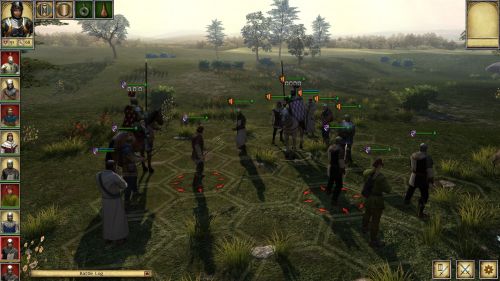
Thanks to an absence of mudhole stomping boots, battles are actually more interesting in the early-game.
Not to say any of those would be doable, but as it is I mostly just bashed stuff, regardless of tactics and thought. What matters most is damage output, and damage output in Legends of Eisenwald is quite high. Battles don’t last near long enough for the players to really knuckle down and think something out. Because troops start dropping like flies the second the action starts, most of my ‘tactical mind’ was spent glancing at the initiative chart and seeing who I could dust out the fastest. Most of my forethought went into dispensing heals and buffs. Most of my real forethought just went into party composition, for a great deal of the ‘problems’ I ran across were handled by hired and upgraded character archetypes and not tactical wit. As harsh as that may sound, I still had a good deal of fun just rounding dudes up and kitting them how I saw fit.
If for nothing else, I have to give props to the game actually doing something different. Branching into new territory comes with its bumps and bruises. The system is not as balanced as I would like, and it seems to set itself a foundation without building much upon it which is a little disappointing. That said, I don’t think Legends of Eisenwald is its combat system – I think it’s more the sum of its larger parts, namely the fun scenario-conquering and party-building. It does market itself more RPG than tactics game, after all.
While I said most time is spent fighting, I really mean most time is spent fighting and/or preparing to fight. In that preparation you’re going to be spending plenty of time zipping back and forth across the map as the scenario dictates. Legends of Eisenwald manages to sustain a fairly interesting story, dispensing lore at every nook and corner. Speaking of which, the lore itself makes for an entertaining read and you get a nice little animated backdrop on which to read it. (Though I do think the devs took the ‘animated background’ a little too far when, in one scene, a peasant feeding some chickens is depicted as having a literally endless shower of corn spraying from his hand like some kind of Monsanto wet dream.)
There is a fair bit of choices to be made. I’m not sure how far they go in affecting the outcome of the game, but within the narrowed spectrum of the scenarios you’ll find plenty of things that may or may not happen based on what you do or don’t do. This includes finding weapons, people, and fighting whole different factions. A lot of the things you hear in the pubs aren’t just there for idle banter and amusement – a great deal of what you hear is essentially saying, “No, really, keep an eye out for this.” While there is technically a quest marker, many quests don’t actually give you much to go off of. The journal’s notes are often not particularly helpful and many quests are best solved in the immediacy following their discovery. I returned to one quest after holiday only to realize I wasn’t sure what the hell to do. Some notes that track dialogue would be nice, but I do know some players like the more ambiguous “just do it!” approach to quest delivery. Other quests have you seeking out certain people, except they may give you names you’ve never even noticed before. This often led to me riding around and staring at my mini-map for the dude’s name to flash over on one of the unit markers. Ah, the thrill of the hunt. Other quests imply a sense of time limit, but rarely is that true. This is good, for as a man that jerks off and listens to Don't Fear the Reaper before he does anything, the last thing I want is to be anxious over some digital demands that I can hardly complete better than their real-life counterparts.
My only beef is that some quests require specific geographic-triggers to continue. In one headscratching moment a quest described me needing to go stand next to a specific rock, then go up a hill, then turn around, and go back down a hill. The only problem was that this quest took place in the mountains where, if you’re not familiar, many, many rocks and hills can be found. When I eventually looked up how to do this quest, someone mentioned to stand next to the debris of a fallen tower. Returning to the game, I found multiple debris piles facing multiple hills at which point I sat a little further back in my chair than I usually do. In another moment, I had a quest where I was intended to fight someone, but I attacked them the same time they entered an enemy watch tower. I ended the ‘siege’ of the tower only for said someone to be unattackable after they left, essentially breaking the quest line. Another quest had me standing in the wrong spot, not kicking in a ‘cinematic’ of me being chased by a group of enemies, but instead just outright fighting them (by myself). I miraculously managed to win these fights, only for the game to dump me back onto the world map with every character frozen. Save often, kids.
The game’s overall content is … quite a damn lot. Based on just how much you wish to read and do, the game provides a big altar on which to sacrifice your hours. Its combat system is unique enough that I don’t think one can get a proper handle on whether or not they like it without first just jumping in. Ultimately, Legends of Eisenwald is what I’d call an overall solid experience. Nothing particularly spectacular about it, but it’s playable. It works. To quote many game reviews: it’s fun if you’re into that kind of thing.
Legends of Eisenwald is available on Steam.
Legends of Eisenwald is – per its own marketing – a RPG/tactics/strategy game set in medieval Germany. While it tries to distance itself from being a fantasy game, it definitely has its fair share of fantastical elements though it tries very hard to take itself more seriously. I’m not sure why devs these days try to shoehorn in how ‘real’ their games are. To quote the game (Steam) box: “it’s a land where the superstitions of the time have come to life. This isn’t a fantasy game.” Dammit devs, you can’t bring superstitions to life and then turn right around and say it isn’t a fantasy game. If ya got spells and wizards and necromancers, it’s got some fantasy! Maybe it’s the fear of getting washed out by the sea of fantasy games in this same genre, but I say don’t be afraid to own it.
That poor opening aside, let’s just get right down to it: Legends of Eisenwald is a solid game.
Who you are and what you do
Picking up a well-worn calling card, the protagonist of the story is on a vengeful warpath as he or she looks for those responsible in bringing down their dynasty. You can pick from three characters – a Knight (melee), Baroness (ranged), and Mystic (magic). Because your characters physically take part in the battles, who you choose can greatly shape how you end up playing the game. That is, after all, one of the subtler differences amongst these genre games: whether or not you, the play-character, physically take part in the battles. Unlike King’s Bounty, without actual spellcasters in your party, you will not be casting very many spells if you are not a spellcaster (read: very many is actually very none). Most of these characters have various ‘leveling paths’ that usually fall along the lines of empire management, army management, and character power-growth. For me, I chose the Knight as it was suggested to be the easiest and I’m a simpleton that likes to bash. Not only that, I also leveled him to be extra-bashy in the early game where he promptly served as a valuable extra-soldier instead of an anchor of ‘potential’ that the Mystic certainly is. With the character choice out of the way, you pretty much jump into the story which is structured by a series of scenarios.
Most scenarios play out almost necessarily obstructive and centripetal: you come into some new tract of territory upon which scurry a handful of lords and barons that dislike one another. The first man you meet says he can do X for you, all you need to is round up the rascals and spalpeens – usually by means of killing one half for the beneficial alliance of the other – and once all that is said and done you’re on to the next scenario wherein the process repeats itself. I have to admit by the later chapters I would be doing a bit of a sideways glance as I read another lord go on about how I needed to unite this particular tract of territory. After a few scenarios I kinda started to wonder, if in every map I leave I’m controlling the majority of the castles and land, why don’t I just… snowball that into an actual army? Uniting lands for some other dick? How about the fact I’m actually just conquering them myself? Amusingly, while worrying word of your nemesis’s army roaming unseen lands meets your ears on every map, nobody seems to notice the last member of a dying dynasty reaping a whirlwind of destruction himself.
In between the here of this scenario and the there of that one, you run across various characters of ill-repute. Taking a page out of Game of Thrones, LoE’s sense of fantasy is a dark one. Most people are intolerable assholes asking you to do dreadful things to which you doth protest not at all. ‘Good actions’ typically require some amount of investment while ‘evil actions’ often expedite the completion of an objective. Would you rather run back and forth across the world in search of something, or just unsheathe your sword and be done with it? Nevermind that most good actions are duplicitous in nature – what you think is a ‘good’ action is, in fact, a naïve and ignorant one that ends rather horribly. Like Game of Thrones, the subversion becomes a trope in and of itself and characters are a little bit too obviously evil.
Of course, the biggest jerk in the game is you, the player character. Peasants look at your lord side-eyed and if you ever get a word with them they respond with the lit-up, faux grin of a noticed Best Buy worker trying to hide behind the DVDs. LoE really plays upon how you are a member of nobility, and how the laymen are way, way beneath your stature. The fantasy trope of the kindhearted liege is very quickly done away with. After the third scenario there should be little doubt that you are, in fact, just another asshole. I quite liked it, though, and there’s a great deal of humor to be found in how narrow-minded your character is in their pursuit of vengeance. I was often reminded of the Russian nobility’s stupidly naïve diaries in its final days. What’s wrong with throwing a few peasants to their deaths? I don’t understand what there is to be upset about.
Legends of Eisenwald is a pretty game in the sense that it is the cutest German girl in a small village. She would become just another face in the engulfing nature of a city, but here in the tiny hamlet her little hair-twisting and skirt-spinning pirouettes make her stand out. I’ve clearly no idea how to talk about graphics or even appraise them, but by my estimations it’s a good looking game. Polygon-wise the characters are detailed enough, textures give them a sense of physical presence, and animations are serviceable. I think the real standout are the maps themselves. They’re intricately made and I can imagine took a great deal of time to get just right. Castles rest in the midst of lakes, murky ponds help mudify the otherwise viridscapes, lots of ruins and rubble strewn about, windmills dot hills and fortresses are oft found tucked between mountains. Oh, and forests. Lots of forests. And copses and pockets of trees where forests used to be. Most maps tend to have one big central city – or two – surrounded by temples, medieval favelas, and black markets. About all of this scurry various lords, lieges, leech-sellers, smellsmocks, witches and their corollary dick-swingin’ ne’er do wells, all manner of peasantry run amuck, bandits, brigands, and thieving graduates, some sickly and poison moistened, the cursed and rabid, the cured and vapid, sellswords and poets selling words and plenty of peddlers, tramps, shamans, pagans, pariahs, necromantic practitioners to dizzy you with lore.

Boats, bridges and lighthouses, the little flourishes man can claim to be art. Only thing missing is a train.
Sound-wise, I’m a bit mixed. The music is fantastic. It dips in and out at appropriate times and is a fair-bit catchy when you’re traipsing about the overworld. A nice little ditty plays for your battles, a little bit of pomp and flair to accompany your man-killings, and it doesn’t fall for the overly abused heavy drums or reverb or whatever the hell it is kids listen to before going into battle these days. The overly ear-friendly lute playing that kicks in when you visit noblemen helps reinforce the gulf between you and the laymen. Nothing like a little pimby-pamby music to accompany the news of how you’ve committed various atrocities in the name of your own personal ambitions. I’ve won you an ally sir, all I needed to do was slaughter every living being that stood before me and sell women into a filthy man’s harem. Doo-dee-doo.
Battle-sounds leave a lot more to be desired. There’s not enough ‘chunk’ to them. Bows go ‘pfft’ and heavy clubs go ‘bang’ and dying men go ‘augh.’ It’s a very 1950s Hollywood rendition of a fight to the death. The way men keel over you almost expect someone to yell out, “…and cut!” A man may die akin to a spirited mannequin, but you can still cover up that awkwardness with some quality sound design. Sound goes a long way in making any game that much better. Naturally, when it’s there we just go and take it for granted, but when it’s missing it’s hard to not notice its absence. What we come to have are what I would call ‘noises.’

Imagine going to Medieval Times, but there are no other spectators or loudspeakers.
Gameplay, or kite-watching in slow motion
Recap for fluff skippers: Legends of Eisenwald is played over a number of scenarios. So what is it you do in those scenarios?
Fight, mostly.
Legends of Eisenwald’s battle system, however, is particularly unique and no doubt the fulcrum upon which will totter both positive and negative opinions about the game. But there are a few steps to be taken before you lay low your enemies.
Firstly, hiring, leveling, and equipping your followers. You don’t recruit armies in LoE, but instead individuals which round out a small band of killers. Followers range from melee brutes, ranged shooters, and spell-casters, not unlike what you had to choose from for your player-character. However, there are some differences amongst these units. They all follow ‘upgrade paths’ which typically diverge into one role or another. A healer may stay on the path to healdom or she might stray into sorcery. Monks can be buff-dealers or holy warriors. Soldiers mostly follow the path of counter-striking spear-wielders or go-get-‘em knights. Ranged units are essentially just a choice between bows and crossbows.
The overall size of your army can be dictated through your player-character’s personal upgrade options or by capturing castles. The castles provide ‘support’ tokens from which your army may increase its size; the more castles you have, the greater the size of your army. Also of note, the more castles you have the more money you’ll have, and the more money you’ll have the better equipment you’ll be buying. More often than not a simple kingly castle acquisition unlocked the doors from feeble squabbling with minor bandits to out-and-out map conquering with an increasingly rambunctious horde and every new opponent more trivial than the last.
Equipping your troops is fairly rudimentary stuff. Weapons largely go where they should as managing the armory proves to be rather perfunctory – maces can ‘stun’ (lower initiative), axes cut through armor, swords riposte, spears poke-first from the long end. Mostly I just went with whatever did the most damage in a timely manner. Because enemies can hurt badly regardless of their health, the fastest way to stop that is to just kill them. Aesthetically speaking, weapons, shields, and horses appear on the characters. Armor does not, as your troops always take a rigidly posed stance with whatever upgrade path you chose. While not the least bit important, I did kind of want to see my outfit of archtramps looking like a wayward dream haranguing a finer-attired world. Alas, the dress code of medieval German is fairly formal.
The biggest adjustments can be found in the choices of amulets as they tend to have a nice variety in options between providing health, initiative, defenses, attacks, and sometimes special bonuses like poison or blessing your weapons. Horses also give various bonuses like health, initiative, and overall asskicking, but usually one comes at the expense of another. One of my riders rode a fleet-footed stallion and usually went first in battles even though he was a very heavily armored grunt. My player-character couched himself atop a studly warhorse adorned in so much armor he would’ve been better off being put on wheels. Said player-character went last in combat, but tended to blast a seismic hole through whatever he touched with his lance.
Which brings us to the combat. Fighting involves a hex-grid with opposing sides bundled into what I can best describe is a no-holds barred cage match. It is akin to a cockfight: you are in such immediate and close proximity to one another with literally no retreating room that the only way to go is forward. Thusly, we find the conceit of Legend of Eisenwald’s combat system: every move goes forward. You attack whomever is closest. Damage is predetermined. Randomness need not apply. That’s largely it.
A large debate could be had on whether or not this system produces more complexity or takes it away. Are we thinking a few moves ahead in terms of who I could attack next? Eh, maybe. Does the lack of obstacles and variety on the field make most ordinary battles feel a bit redundant? Ah, yeah. But I think it’s the wrong way to look at it. Most of the combat really occurs in the preparation. Fine-tuning your army into what best suits your tastes is how you really beat up enemies. It’s in the aforementioned hiring of troops and then molding them into the sort of troops you want. I played a Knight, so I gave my player-character a horse and a two-handed sword in case the animal was felled. He was accompanied by strong-armed fellow knights and soldiers, as well as a retinue of weaklings known as healers and buffers. Once fine-tuned, this squad steamrolled everything in its path. I’ve seen Disciples brought up as a sort of comparison for this game and, strangely enough, it’s rather apt. Even though there is a sense of tactics, most battles feel like they have a natural winner/loser before the first blow is even landed. A medieval documentary is had: watch as the knight displays a double-kill on the lowly pikemen whose polearms should stop any mount (but not this one), and now watch as he preys upon the backline of women and weak men. Not a one of them stood a chance.
I think the combat is weak in that it’s not fully balanced, if that makes sense. The system of advance and what I would call ‘ranged zone of controls’ (being forcefully marched to the closest enemy) is an interesting one. The problem is that the battle lines are very easily shifted and once the front row is mangled a rout is quickly had – and that front row is quickly mangled. There is not near enough time to really let battles become entrenched and the skills aren’t diverse enough to allow for some interesting plays.
For example, non-healing potions are largely useless and I found myself almost never using the abilities of my soldiers. Why waste a turn when it can be used doing damage? A potion that gives me +10 attack is not going to be worth the total damage lost from drinking it for a turn. Special abilities are largely the same: why save up for 150% when I can do 100% damage this turn, and 100% damage the next? In a true oddity, I found myself using potions and abilities as turn-skips, lest I throw my soldiers to their doom. And I do mean forced to kill off my own soldiers: you might have someone whose only possible command is to march into a polearm (which gets a first-strike bonus). But! If you have a potion, you can drink it and skip that turn instead.
When your grunts get wounded (any damage that deals over half their health in one hit, which kinda shows you just how much damage characters are doing to one another), they can no longer be healed beyond a certain point. Thusly, a great deal of time is spent tending church on weekdays to get your men back on their feet. There are potions for healing wounds, but I never found a use for them that a pile of gold couldn’t deal with. Rarely are you far off from a holy man’s healy hands. As far as actual healing goes, the system does suffer from a very classic issue: if I have characters that can heal, why can’t I heal after battles? What I ended up seeing are a few battles where, after the fighting was all said and done, I actually began skipping turns as much as possible to let my healers heal everyone up, and then ended the fight. Legends of Eisenwald is not uniquely labored by this problem, but I always felt flaws like this showed a lack of foresight in game design. Eh, maybe that’s just me though. (Whenever the topic is discussed I tend to stand straight up like the Manchurian candidate and proclaim my robotic defense of Dragon Age’s auto-healing so maybe I’m the one with real issues.)
Given the nature of attacking who is closest, the game seems to be missing skills that would have allowed for a bit more dynamic gameplay without sacrificing its purported goals. You can have an ‘assassin’ for example, but he’s largely worthless because he’s only good for killing backline enemies – but once you get to the backline, the battles are already over (enemies auto-retreat once decimated to helplessness), and bowmen are already capable of dealing damage to backliners without needing move an inch. Would it not be interesting, then, if knights with shields could “bash” enemies out of the way, opening lanes, and then characters like assassins or duelists could be a melee-form of archers: ignoring the system’s rules and attacking whoever they wish by cruising through enemy lanes. Thinking defensively, why not allow polearms to ‘redirect’ people? If a polearm stretches over the frontline, why not have it ‘stop’ people from getting into that front line? Polearms go from gimmicky first-strikers to shapers of battle lines. Instead of just ganging up on the enemy, their polearms funnel you into their frontlines where they gang up on you! A clash of the melee troops while bowmen and pavise-toting crossbowmen exchange fire and healers expend their mana would have made for some interesting gameplay. Mayhaps one of those character skills I never used could be a “charge” that needs one turn to get ready, and then you can charge through the poles to make contact with the frontlines. Speaking of charge, I actually thought the horse 'charge' mechanic (where, if you kill someone, you can take your turn again) would only activate if I 'charged' from the backrow. As it turns out, you can charge someone standing two feet in front of you. Maybe the bonuses of a charge should carry the drawback of needing to put your riders further back? I dunno. Ideas here, folks! Throwing out ideas!

A literal spearwall, but not really.

Thanks to an absence of mudhole stomping boots, battles are actually more interesting in the early-game.
Not to say any of those would be doable, but as it is I mostly just bashed stuff, regardless of tactics and thought. What matters most is damage output, and damage output in Legends of Eisenwald is quite high. Battles don’t last near long enough for the players to really knuckle down and think something out. Because troops start dropping like flies the second the action starts, most of my ‘tactical mind’ was spent glancing at the initiative chart and seeing who I could dust out the fastest. Most of my forethought went into dispensing heals and buffs. Most of my real forethought just went into party composition, for a great deal of the ‘problems’ I ran across were handled by hired and upgraded character archetypes and not tactical wit. As harsh as that may sound, I still had a good deal of fun just rounding dudes up and kitting them how I saw fit.
If for nothing else, I have to give props to the game actually doing something different. Branching into new territory comes with its bumps and bruises. The system is not as balanced as I would like, and it seems to set itself a foundation without building much upon it which is a little disappointing. That said, I don’t think Legends of Eisenwald is its combat system – I think it’s more the sum of its larger parts, namely the fun scenario-conquering and party-building. It does market itself more RPG than tactics game, after all.
While I said most time is spent fighting, I really mean most time is spent fighting and/or preparing to fight. In that preparation you’re going to be spending plenty of time zipping back and forth across the map as the scenario dictates. Legends of Eisenwald manages to sustain a fairly interesting story, dispensing lore at every nook and corner. Speaking of which, the lore itself makes for an entertaining read and you get a nice little animated backdrop on which to read it. (Though I do think the devs took the ‘animated background’ a little too far when, in one scene, a peasant feeding some chickens is depicted as having a literally endless shower of corn spraying from his hand like some kind of Monsanto wet dream.)
There is a fair bit of choices to be made. I’m not sure how far they go in affecting the outcome of the game, but within the narrowed spectrum of the scenarios you’ll find plenty of things that may or may not happen based on what you do or don’t do. This includes finding weapons, people, and fighting whole different factions. A lot of the things you hear in the pubs aren’t just there for idle banter and amusement – a great deal of what you hear is essentially saying, “No, really, keep an eye out for this.” While there is technically a quest marker, many quests don’t actually give you much to go off of. The journal’s notes are often not particularly helpful and many quests are best solved in the immediacy following their discovery. I returned to one quest after holiday only to realize I wasn’t sure what the hell to do. Some notes that track dialogue would be nice, but I do know some players like the more ambiguous “just do it!” approach to quest delivery. Other quests have you seeking out certain people, except they may give you names you’ve never even noticed before. This often led to me riding around and staring at my mini-map for the dude’s name to flash over on one of the unit markers. Ah, the thrill of the hunt. Other quests imply a sense of time limit, but rarely is that true. This is good, for as a man that jerks off and listens to Don't Fear the Reaper before he does anything, the last thing I want is to be anxious over some digital demands that I can hardly complete better than their real-life counterparts.
My only beef is that some quests require specific geographic-triggers to continue. In one headscratching moment a quest described me needing to go stand next to a specific rock, then go up a hill, then turn around, and go back down a hill. The only problem was that this quest took place in the mountains where, if you’re not familiar, many, many rocks and hills can be found. When I eventually looked up how to do this quest, someone mentioned to stand next to the debris of a fallen tower. Returning to the game, I found multiple debris piles facing multiple hills at which point I sat a little further back in my chair than I usually do. In another moment, I had a quest where I was intended to fight someone, but I attacked them the same time they entered an enemy watch tower. I ended the ‘siege’ of the tower only for said someone to be unattackable after they left, essentially breaking the quest line. Another quest had me standing in the wrong spot, not kicking in a ‘cinematic’ of me being chased by a group of enemies, but instead just outright fighting them (by myself). I miraculously managed to win these fights, only for the game to dump me back onto the world map with every character frozen. Save often, kids.
The game’s overall content is … quite a damn lot. Based on just how much you wish to read and do, the game provides a big altar on which to sacrifice your hours. Its combat system is unique enough that I don’t think one can get a proper handle on whether or not they like it without first just jumping in. Ultimately, Legends of Eisenwald is what I’d call an overall solid experience. Nothing particularly spectacular about it, but it’s playable. It works. To quote many game reviews: it’s fun if you’re into that kind of thing.
Legends of Eisenwald is available on Steam.
There are 115 comments on RPG Codex Review: Legends of Eisenwald





